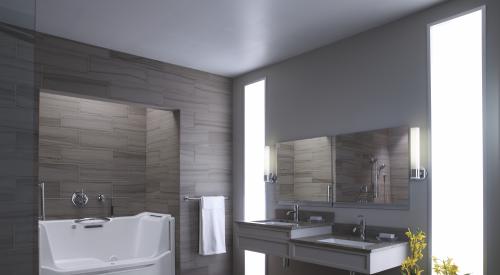Builders find benefits in aging-in-place design. According to the Joint Center for Housing Studies of Harvard University, by 2030, about 20 percent of the U.S. population will be classified as elderly. Over the next 50 years, the percentage of retirees will more than double.
Many segments of the U.S. market are not prepared for this dramatic demographic change, and the housing market is no exception. The majority of homes under construction are not designed for the homeowner 10 or 20 years from now.
That's where aging-in-place design comes in, helping homeowners to remain in their homes safely, independently and comfortably regardless of age, income or physical ability.
AARP reports 89 percent of the 55-and-older population wants to stay in their homes as long as possible.
And all those baby boomers? Many home buyers 45 years and older will want modifications that ensure they maintain their independence for years to come.
Savvy builders will use this opportunity to improve home quality and home sales.
Life LessonsThanks to AARP, more home buyers are beginning to ask builders for aging-in-place designs.
"It was pretty rare, but now it seems like people are actually thinking about things like switch placement and cabinet height," says Michael Kuzenski, a project manager for Dallas production builder Hawkins-Welwood Homes.
Many builders report clients have a limited understanding of aging in place — but when they learn more, they're sold.
"It makes practical sense to most of them, regardless of their age group," says John Overbeck, owner of Turning Leaf Homes Inc., a small custom-home builder in Saranac, Mich.
"People want to be prepared," Overbeck says. "I've done aging-in-place design for families who want their homes to be more accessible for aging relatives."
Every Little ThingThe main reason people are sold on aging in place is that it often doesn't cost anything. Many aging-in-place design features don't cost anything now, but if overlooked, they'll cost a whole lot later on.
Many measures are small, like adding lever handles on faucets and doors; installing grab bars in baths and showers; lowering light switches and raising outlets; lowering window heights; and even using higher-contrast color schemes to empower people with weakening eyesight. It's also helpful to think long-term about lighting placement, to ensure consistent light through the room.
Another quick and inexpensive feature is widening doorways and hallways — preferably to 36 inches or wider.
"Wider doors and hallways make a home feel much larger and comfortable. It has a much greater impact on the feel of a home than a slightly larger room," says Jim Wurzel, a builder for The Cambridge Company of Vienna, Va.
Which goes to show that many features in aging-in-place design accommodate not just the elderly but improve comfort for the rest of the family as well.
Rooms for the FutureMany measures can be adopted in kitchens and bathrooms.
"Those are the two areas that pose the biggest problems to people who need a little bit of extra help," says Overbeck.
In the bathroom, install a grab bar in the shower or tub, or, at the very least, leave a place for it to be installed in the future. Other options include replacing shower door tracks with a trackless system. In the case of a stand-up shower, builders can consider a curbless entry to allow easier access. An integral or fold-up shower seat will aid someone with less mobility or leg strength. A high-rise toilet will also be helpful to someone in a wheelchair.
In the kitchen, consider modifications to allow under-counter knee space for people in wheelchairs or who need to be seated due to back or leg problems. Similar benefits are obtained with pullout shelves, which provide accessible work surfaces and storage for all members of a household.
Various appliances, such as side-by-side refrigerators and stoves with front-mounted controls, offer greater accessibility. Place the microwave or wall oven 31 inches off the floor, while the dishwasher and front-loaded clothes washers and dryers can be elevated 6 to 8 inches off the floor. They should be accessible from both the right and left sides.
Better Design, Better BusinessAARP helps teach builders through its work with the NAHB Certified Aging in Place Specialist (CAPS) designation program.
NAHB's three-day curriculum has three parts: techniques for working with older adults and marketing to them, specific home modification measures, and business management skills.
"It's very good training. I use it all of the time," Kuzenski says. "We gear a lot of our townhouses to empty nesters, so it has become very useful for me. With the elderly folks who are interested in no maintenance or who do a lot of traveling, this is the perfect opportunity to use these principles."
While the CAPS course does focus on a lot of retrofit and remodeling situations, builders should have no problems culling valuable information from the course.
| Author Information |
| Scott T. Shepherd writes about better building practices on behalf of PATH. Scott is an associate with D&R International, an environmental consulting firm with offices in Maryland and California. |








